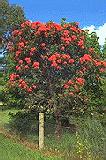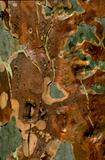|
[Front Page] [Features] [Departments] [SGAP Home Page] [Subscribe]

Eucalypts but not Eucalyptus
Brian Walters
Gum trees (Eucalypts) are the essence of the Australian flora (and that's not just a pun about the aromatic foliage!). There are few Australian environments where Eucalypts are not found. Yes, there are 100 or so species which occur outside of Australia but around 700 are Australian endemics. Even people who wouldn't know a Banksia from a Begonia know what a gum tree looks like and smells like. Soldiers returning by ship from the first and second world wars are rumoured to have been able to smell the aroma of the Eucalypt before land was visible on the horizon. Most Australians may not be able to identify a particular species (there are hundreds of the bloody things after all!) but they will know "that's a Eucalypt".
What is Eucalyptus?
Given the close association of Australian nationalism and the Eucalypt, it's a brave botanist who interferes with the taxonomy. Some years ago it was proposed that the genus Eucalyptus should be divided into several genera by raising the seven sub-genera developed by Pryor and Johnson in 1971 to generic level. This suggested revision was catered for in Elliot and Jones' "Encyclopaedia of Australian Plants" Vol.4 where the proposed new generic names were given in addition to the generally accepted names. The new generic names included Symphiomyrtus, Corymbia, Eudesmia and Monocalyptus).
Supporters of the proposed changes pointed to the genus Angophora, a close relative of Eucalyptus and which has greater similarity to some Eucalyptus groups than do some other Eucalyptus species. Angophora is fairly easily distinguished from Eucalyptus in the lack of an operculum (flower bud cap) and in the opposite (rather than alternate) leaves, although this is not strictly a unique characteristic. In other respects Angophoras are just as much "Gum Trees" as any Eucalyptus....A.costata, for example is known as the "Sydney Red Gum".
Opponents of the changes countered by suggesting that a logical course of action would be to reclassify Angophora as another sub-genus within Eucalyptus (ie removing Angophora as a distinct genus).
Changes
The move to officially publish the new names seemed to die down for some years probably due to the controversial nature of the proposals and opposition to the change both within both the general and botanical communities. The proposals were not adopted for the four-volume "Flora of NSW", published between 1990 and 1993 and, as the Flora was published by the NSW Royal Botanic Gardens (where the proposals for change originated), opponents of change may well have believed that the issue was "dead".
In 1995, however, Ken Hill and Dr Laurie Johnson published "A revision of the bloodwoods, genus Corymbia (Myrtaceae)" in Telopea, Volume 6(2-3), the journal of plant systematics published by the National Herbarium of the New South Wales Royal Botanic Gardens. This major work described 113 species in the new genus Corymbia, 33 of which were described for the first time and the remainder being reclassified from Eucalyptus.
The new genus comprises those Eucalypts in the 'bloodwood' and 'ghost gum' groups and its closest relative is Angophora. The reclassified species include some of the most well known and popular of the eucalypts including E.gummifera, the first Eucalypt to be collected (by Banks and Solander in 1770 at Botany Bay). Some of the better known species involved in the reclassification are:
- Eucalyptus ficifolia ("Red Flowering Gum") = Corymbia ficifolia
- Eucalyptus maculata ("Spotted Gum") = Corymbia maculata
- Eucalyptus gummifera ("Red Bloodwood") = Corymbia gummifera
- Eucalyptus eximia ("Yellow Bloodwood") = Corymbia eximia
- Eucalyptus citriodora ("Lemon scented Gum") = Corymbia citriodora
- Eucalyptus calophylla ("Marri") = Corymbia calophylla
- Eucalyptus ptychocarpa ("Swamp Bloodwood") = Corymbia ptychocarpa

The "Red Flowering Gum", Eucalyptus ficifolia...opps, sorry, Corymbia ficifolia is probably the most spectacular of the Bloodwoods and displays its red, pink or white flowers at Christmas in southern Australia even on quite small trees. Select the thumbnail image or plant name for a higher resolution image (45k).
What does all of this mean to the average enthusiast? Probably not much. The specific names for the reclassified Eucalyptus species remain unchanged in Corymbia so there is little scope for confusion (calling a plant Eucalyptus ficifolia or Corymbia ficifolia will be understood as referring to the same species).
However, there is bound to be resistance to the change if only for the fact that there is no easily identifiable characteristic that sets Corymbia apart from Eucalyptus for the average person. The distinctive characteristics of Corymbia are at a fairly subtle level and there is no obvious characteristic of bark, bud, fruit or foliage which clearly says "this is Corymbia" in the way that Angophora is easily recognised as being different from Eucalyptus. So acceptance of the revision will probably be a slow process.
Despite this, there doesn't seem to be much doubt that the reclassification is based on considerable research and investigation extending over many years. Furthermore, the fact that there are 33 species which don't have any other name will probably lead to Corymbia being eventually accepted by even the most recalcitrant Eucalyptus enthusiast.

The mottled bark of the "Spotted Gum", Corymbia maculata makes this tree one of the most easily identified of the Eucalypts. Select the thumbnail image or plant name for a higher resolution image (30k).
There may be one or two "unintended consequences" of the revision. As reported in the Sydney Morning Herald on January 27 1996, the Australian Labour Party may have to rewrite the story of its foundation. One version of the story is that the Party was formed under the "Tree of Knowledge" in Barcaldine, Queensland during the Shearer's strike in 1891. The "Tree of Knowledge" still exists in Barcaldine and was previously known (incorrectly) as Eucalyptus papuana. The tree is now classified as Corymbia aparrerinja.
A Gum Tree by any other name....
Does the reclassification of some members of Eucalyptus into another genus really change anything? It doesn't stop them being Eucalypts as Hill and Johnson take great pains to emphasise: "We would stress once more that the English term 'eucalypts' (and its equivalents in other modern languages) should be used to include all of the complex discussed..... Thus 'the eucalypts' are Angophora + Corymbia + Eucalyptus + any other genera which may be segregated; it is not an equivalent of the genetic concept of Eucalyptus......The notion that angophoras are not eucalypts has lasted for too long."
And what of the future....will Eucalyptus be further segregated and will names like Symphiomyrtus and Monocalyptus enter our horticultural vocabulary? Only time will tell. However, at a recent visit to the Mt Tomah Botanic gardens (the cold climate garden of the NSW Royal Botanic Gardens) I noticed a plant labelled Symphiomyrtus perriniana. Symphiomyrtus? Now where had I seen that name before? The plant is still officially known as Eucalyptus perriniana (the "Spinning Gum"), so perhaps the Gardens are laying the groundwork for some further movement in the genus Eucalyptus.
Brian Walters has been growing Australian plants since the early 1970s. He is a Public Health Engineer and obtained his enthusiasm for the Australian flora while working within the water catchment areas maintained by his employer, Sydney Water. He has been a member of the Society for Growing Australian Plants for over 20 years and is currently the newsletter editor for the New South Wales Region of the Society.
 [Front Page] [Features] [Departments] [SGAP Home Page] [Subscribe]
[Front Page] [Features] [Departments] [SGAP Home Page] [Subscribe]
The Society for Growing Australian Plants
|